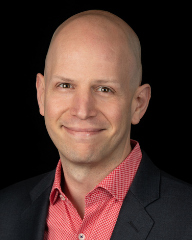Interview by Cecily Garber
Michael Nachbar is executive director of Global Online Academy, a global consortium of independent schools that provides classes for students, professional development for teachers and an international network of peers for school communities.

Global Online Academh
Net Assets: Global Online Academy worked closely with dozens of schools this past spring as they transitioned to fully online education. What factors helped schools make that transition effectively?
Michael Nachbar: The first thing many of those schools did was articulate their “north.” They not only ensured their work was mission-aligned, but also explained to families how their school’s pedagogical philosophy drives curriculum planning for both online and on campus programs. It’s important that schools have a single pedagogy for both.
How would people describe the learning environment? Those adjectives should be what you’re striving to create for every learning environment. This is an opportunity to go back to your roots and think about teaching and learning in a really pure way. Successful schools also clearly articulated learning outcomes.
In a virtual environment, teachers are the face of the school in a way they hadn’t been before. They have always been the heart of our schools, but now their faces are literally in students’ homes, and there are more opportunities for faculty to interface with families than ever before. So having a clearly articulated language that everyone shares is important. That language can address competencies or habits of mind and skills or curricular goals. That’s knowing your north.
Communicating those outcomes clearly was one of the most significant differentiating factors between schools that have navigated this shift successfully and schools that have struggled. The schools that are doing that well are hearing fewer complaints from families, and schools that are not leading with a clear message are getting a lot of pushback because people want to know why. Why are you doing this and not that? The communication piece is absolutely critical.
We have a saying at GOA that online is a platform, not a pedagogy. The pedagogy behind the learning experience should be consistent.
Net Assets: So online education really shouldn’t be a factor in articulating value proposition, right? Value proposition can be just as strong in online learning as on-campus learning?
Nachbar: Yes. Schools shouldn’t bifurcate between online and on-campus. We have a saying at GOA that online is a platform, not a pedagogy. The pedagogy behind the learning experience should be consistent. That’s not to say there aren’t different strengths to each environment. Be clear about those strengths. Name those things.
Online learning will be part of our schools’ programs from here on out, so schools should be really deliberate about not making the online portion seem like a lesser version of on-campus learning. A lot of schools use an apologetic tone when describing the online work they’re doing, and they should move away from that, because it most likely isn’t going away in the long term. Positioning it now as a critical piece of the program is a strategic move.
Net Assets: What investments and budgeting decisions might schools make to improve school-wide communications about learning outcomes and value proposition?
Nachbar: Schools need to invest in professional learning for their teachers. Faculty are on the front lines. Everybody is looking at what they’re doing. At some point in the fall we will most likely be online again. Teachers have to skill up, and schools need a focused plan for helping them do that. A “choose your own professional learning” philosophy is not going to prepare your faculty for next year. I know schools are needing to make some hard choices in terms of budgets right now, but investing in your faculty will be one of the things that pays off in great ways.
I know schools are needing to make some hard choices in terms of budgets right now, but investing in your faculty will be one of the things that pays off in great ways.
The shift to online learning may also allow for school leaders to rethink different components of our schools and how we utilize campus space. Will you require students to be on campus everyday like you did before? Could you use classrooms differently or repurpose larger group spaces? This could inspire schools to think differently about enrollment. And there will definitely be staff who will be interested in continuing to work remotely. What does that mean for salaries? For benefits? For culture and systems?
At GOA, we’ve also begun to rethink student-teacher ratios and how we assign teachers to students. Rather than looking at students-per-course, we’re looking at students-per-teacher because online learning gives us flexibility in how we group students. So, for example, rather than thinking about two classes of 15 students each, we have 30 students per teacher, and that teacher can break down the students into smaller groups in the way it makes sense for the work they’re engaged in. Cohorts can remain small and hyper-relationship based, while we don’t limit teachers who perhaps want to engage with more students from reaching more students.
Net Assets: From your perspective, it seems the door is open to reinvent almost all aspects of school operations and program delivery. That’s a lot to tackle. How can school leaders break down these many considerations and make decisions?
Nachbar: Schools need to think about all this as an opportunity. Again, a lot of this manifests in a school’s communications plan. Schools need to communicate that they’re thinking deeply about all aspects of their school – finance and operations, teaching and learning, campus usage and the different options that lay ahead.
You’re considering different aspects and scenarios, but that doesn’t mean you need to choose one right now. Let your community know there are the options on the table and that you will remain flexible in making decisions. I think schools are sometimes held back by the desire for a perfect plan, and then refrain from talking about an idea until it’s fully formed. But that desire for perfection of a super-honed message is going to get in the way of schools laying out options. Opening the table for discussion and considering new and different options is a big exercise, but it’s what we’re seeing in the most successful schools.
Net Assets: Were there any silver linings to the turmoil of the spring?
Nachbar: One thing that schools need to take advantage of is this idea we call the “teacher fallacy.” As educators, we’ve all heard at some point in our careers the sentiment that, because someone attended school, they are qualified to teach in a school. What a lot of parents and guardians have discovered after helping their students learn at home is that teaching is a challenging profession and that teachers are, in fact, experts in their field. Schools need to run with that.



